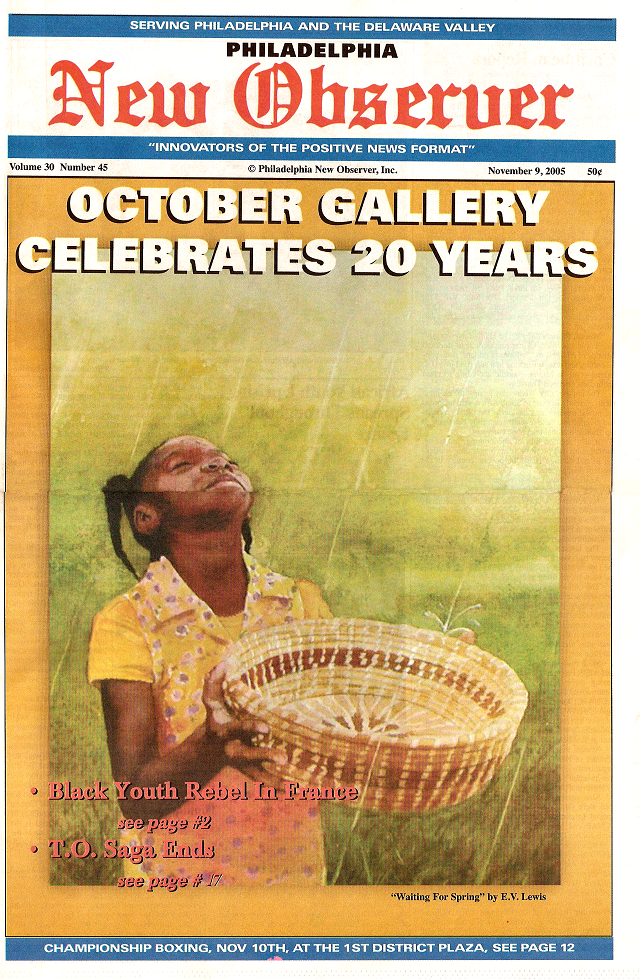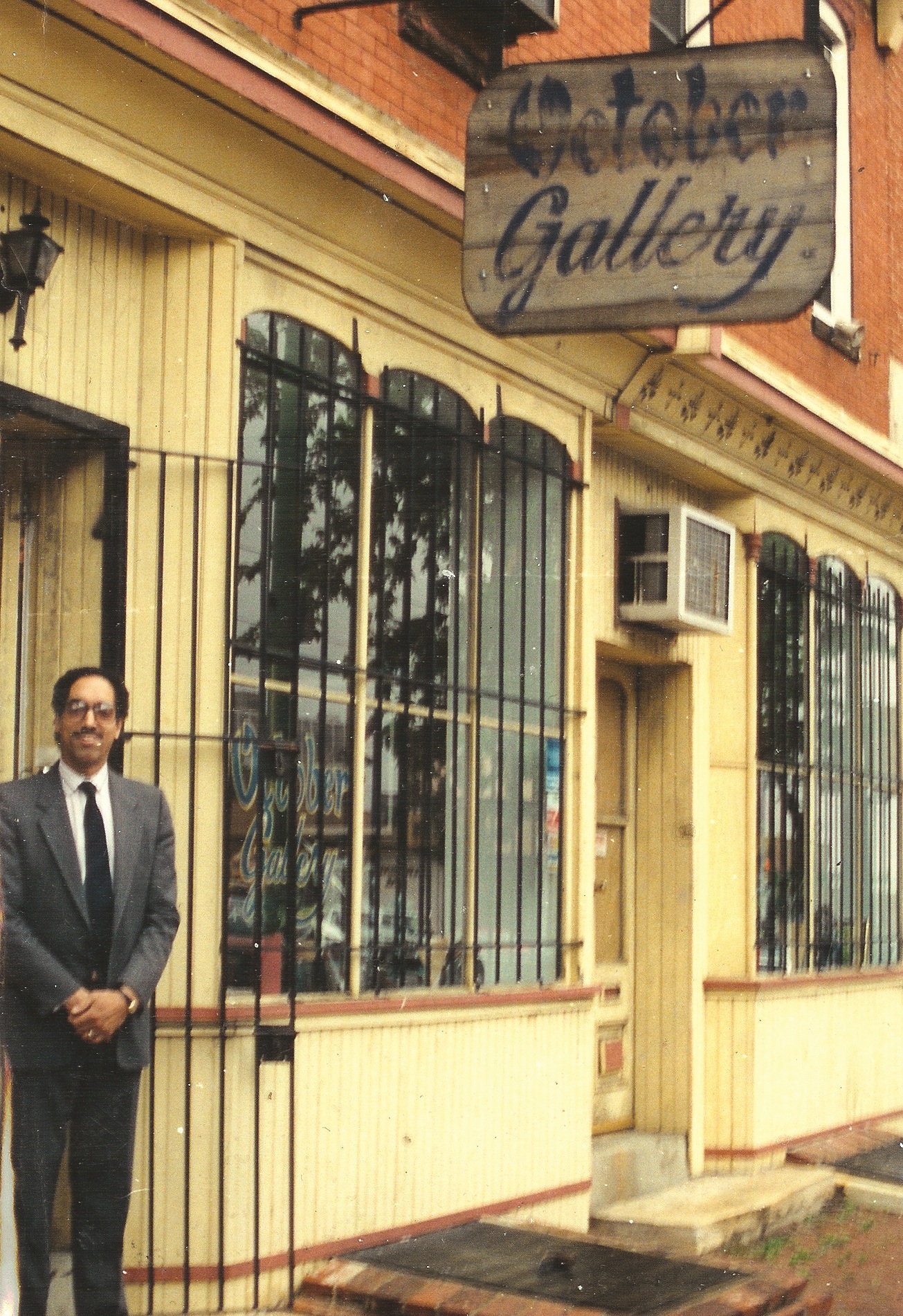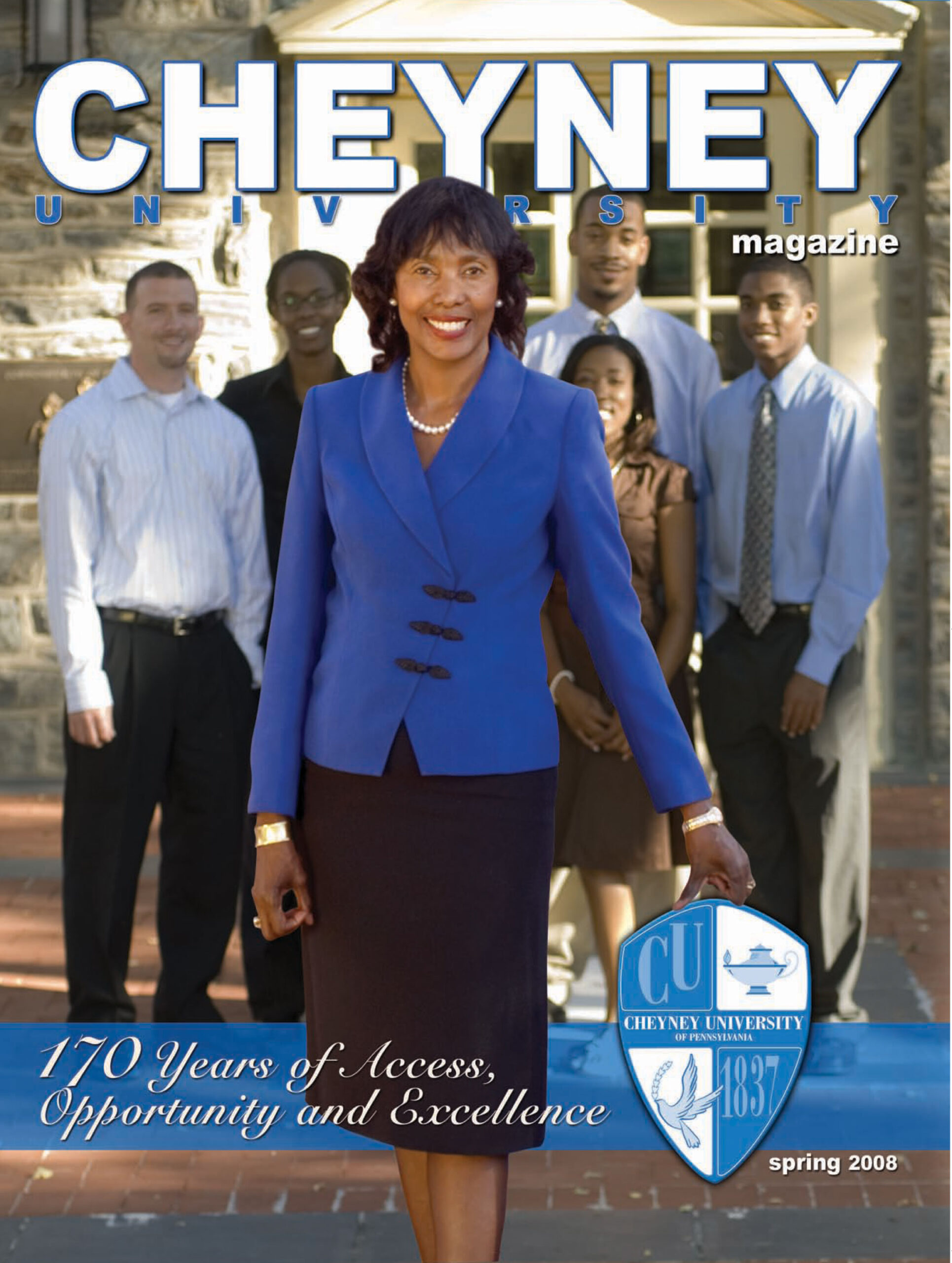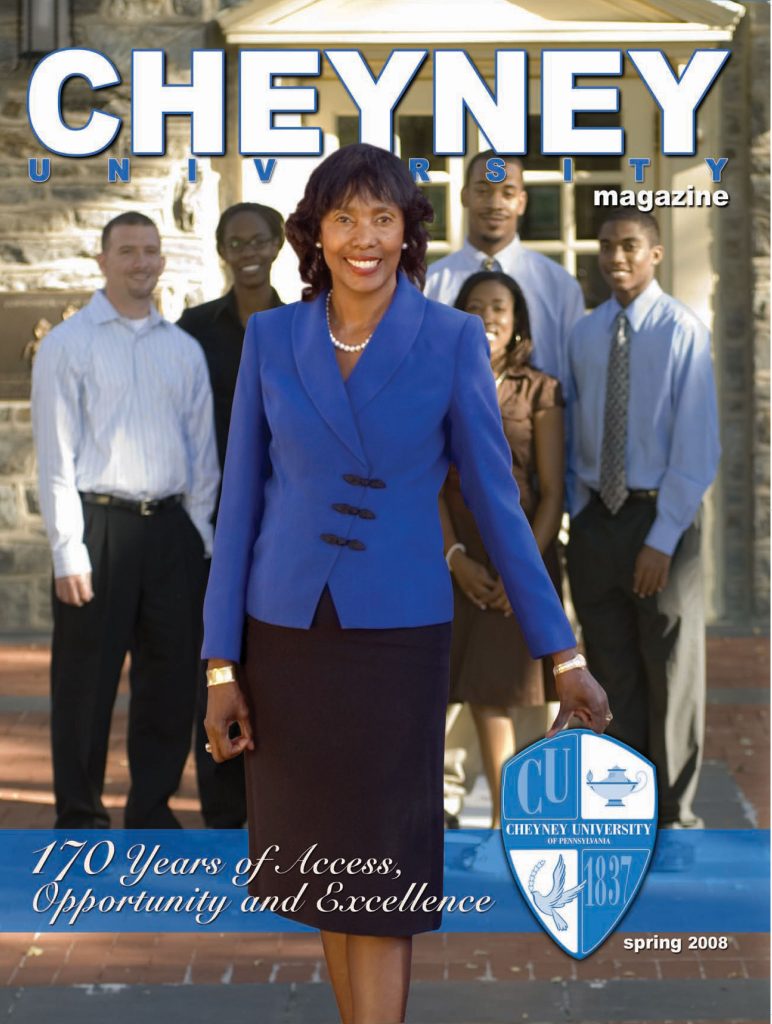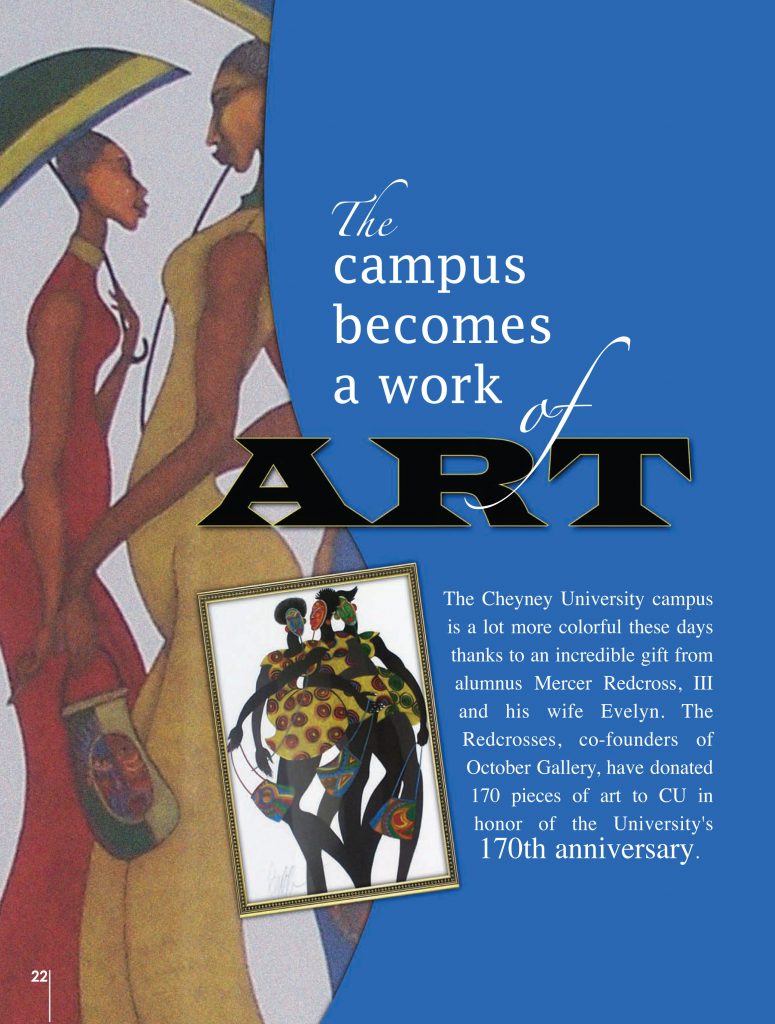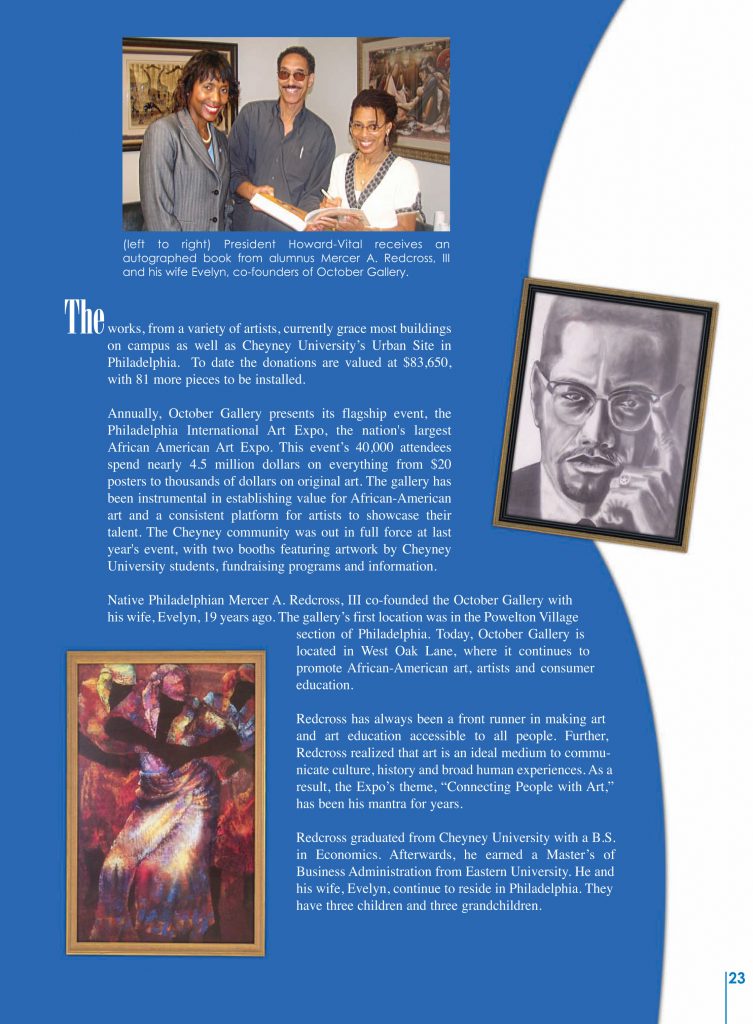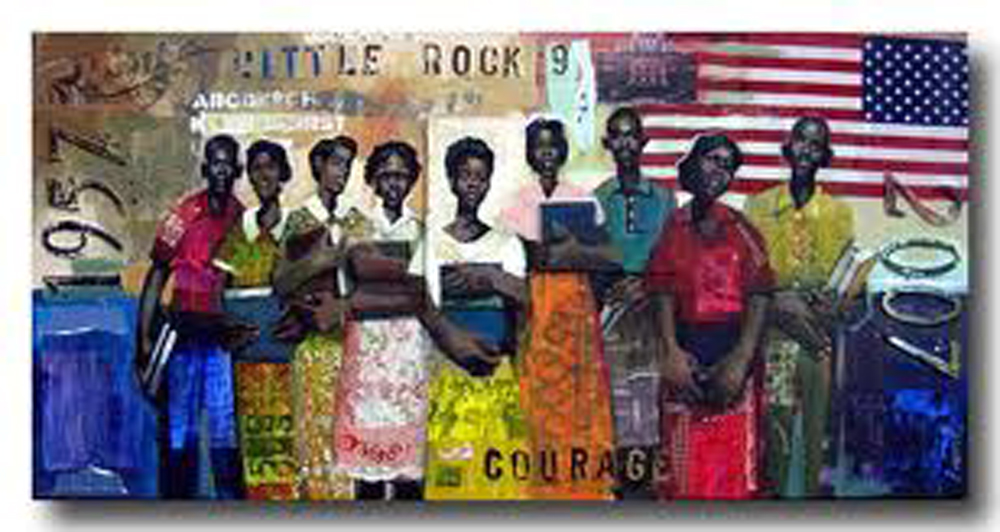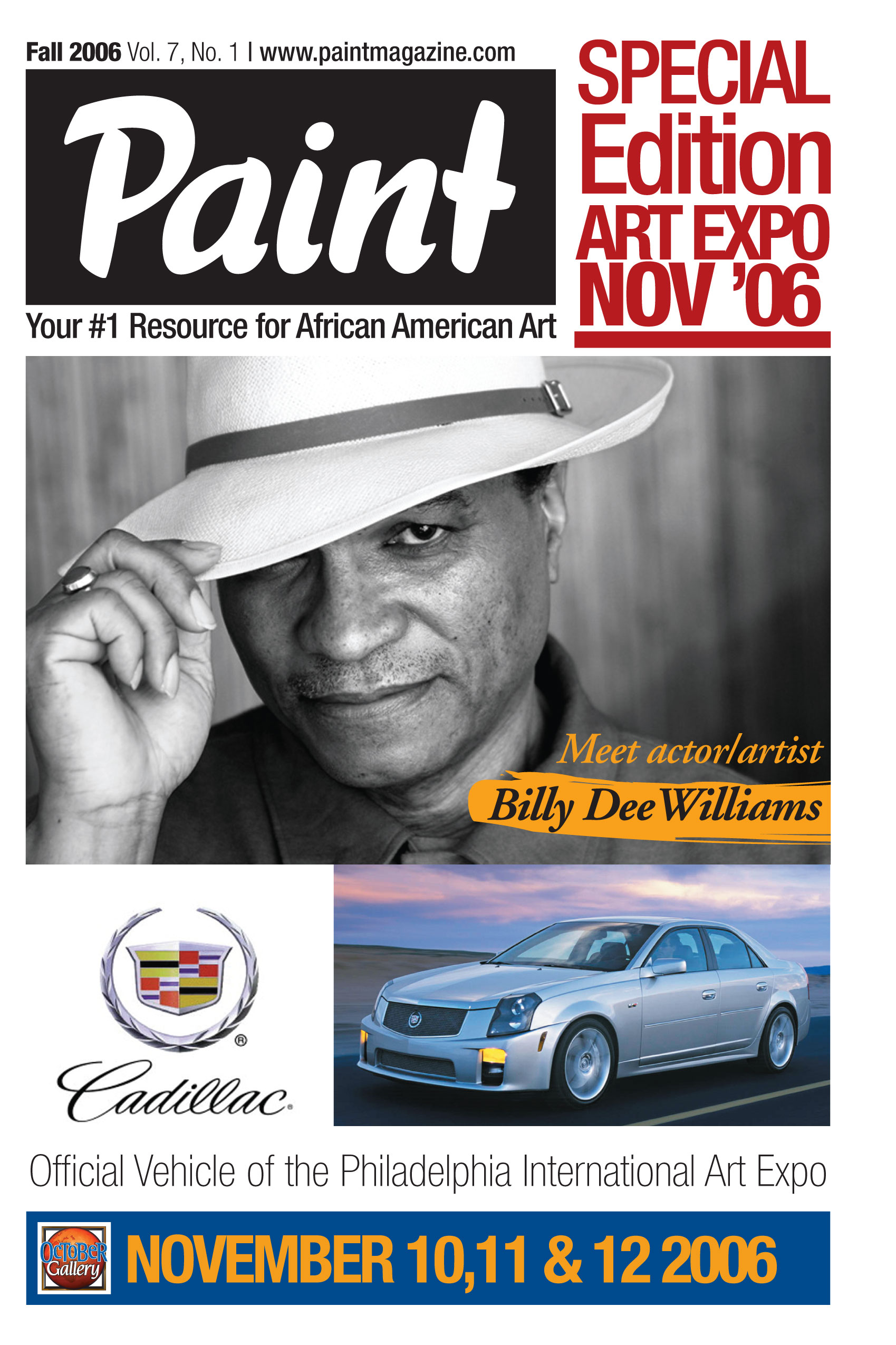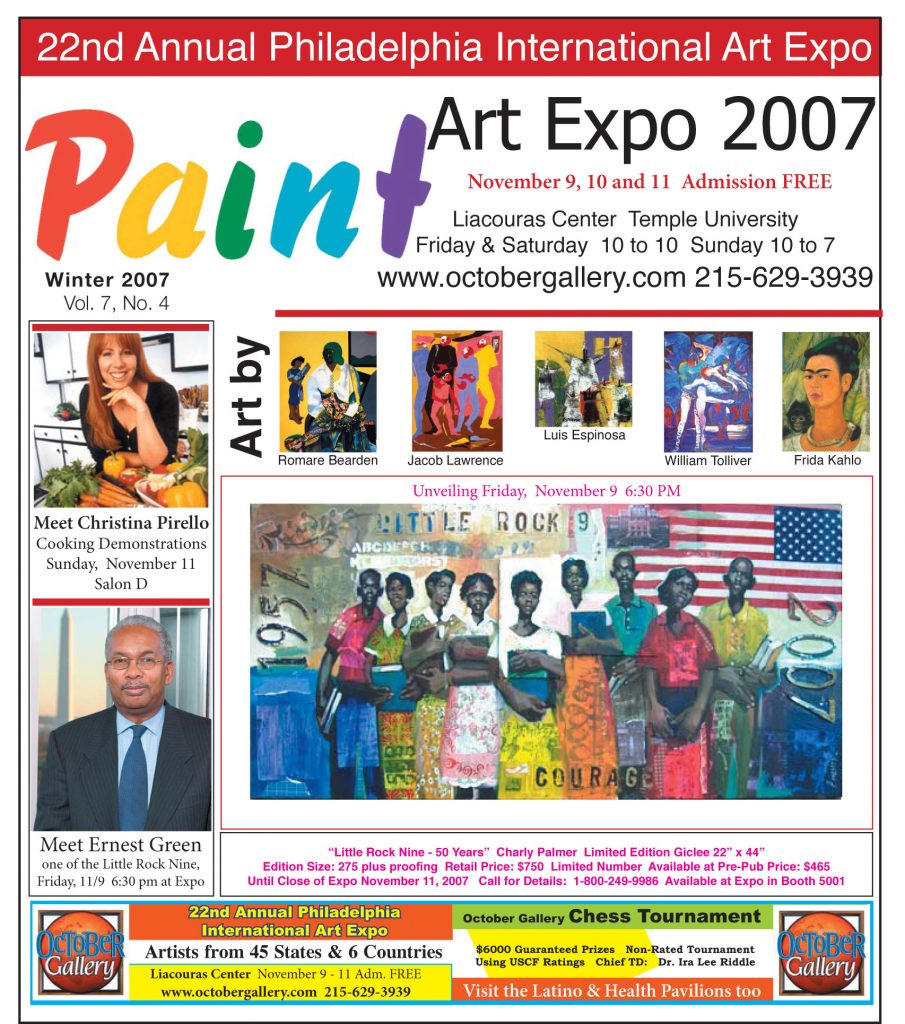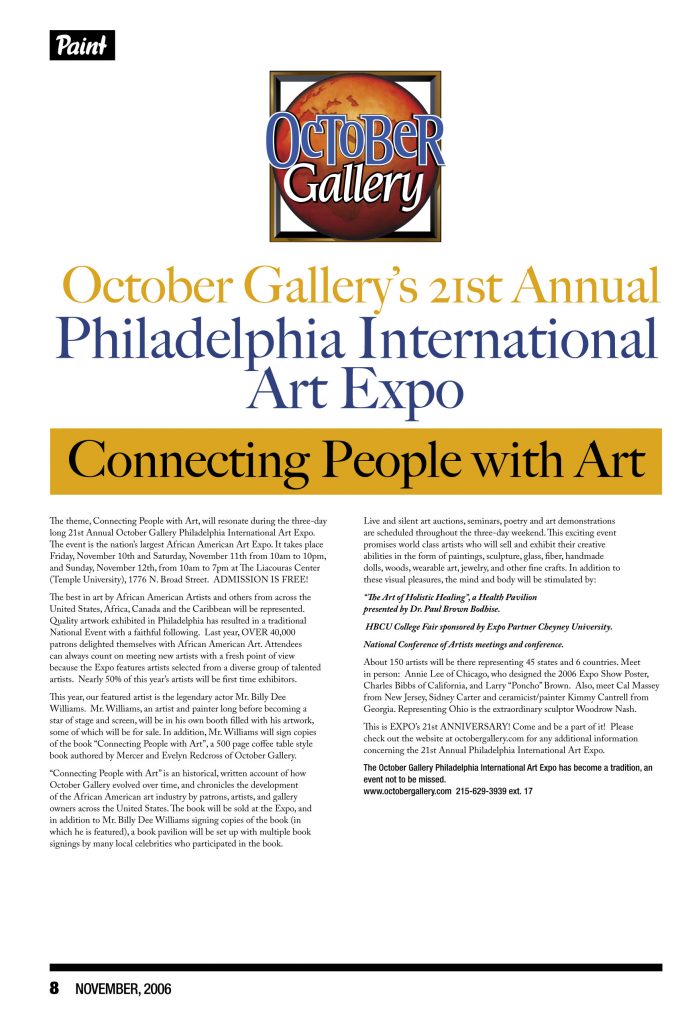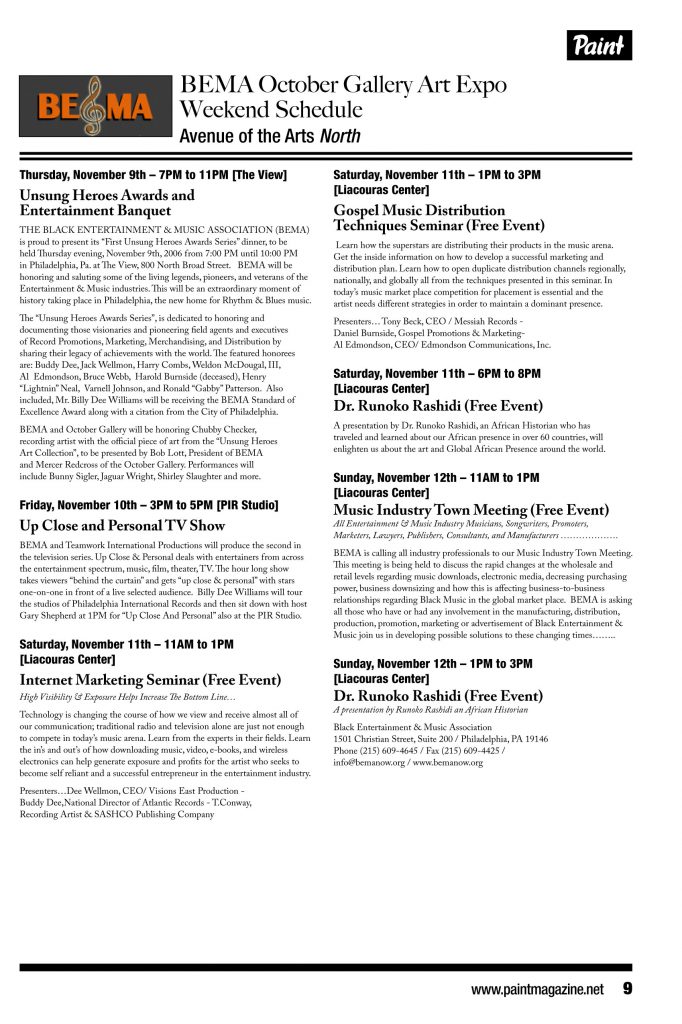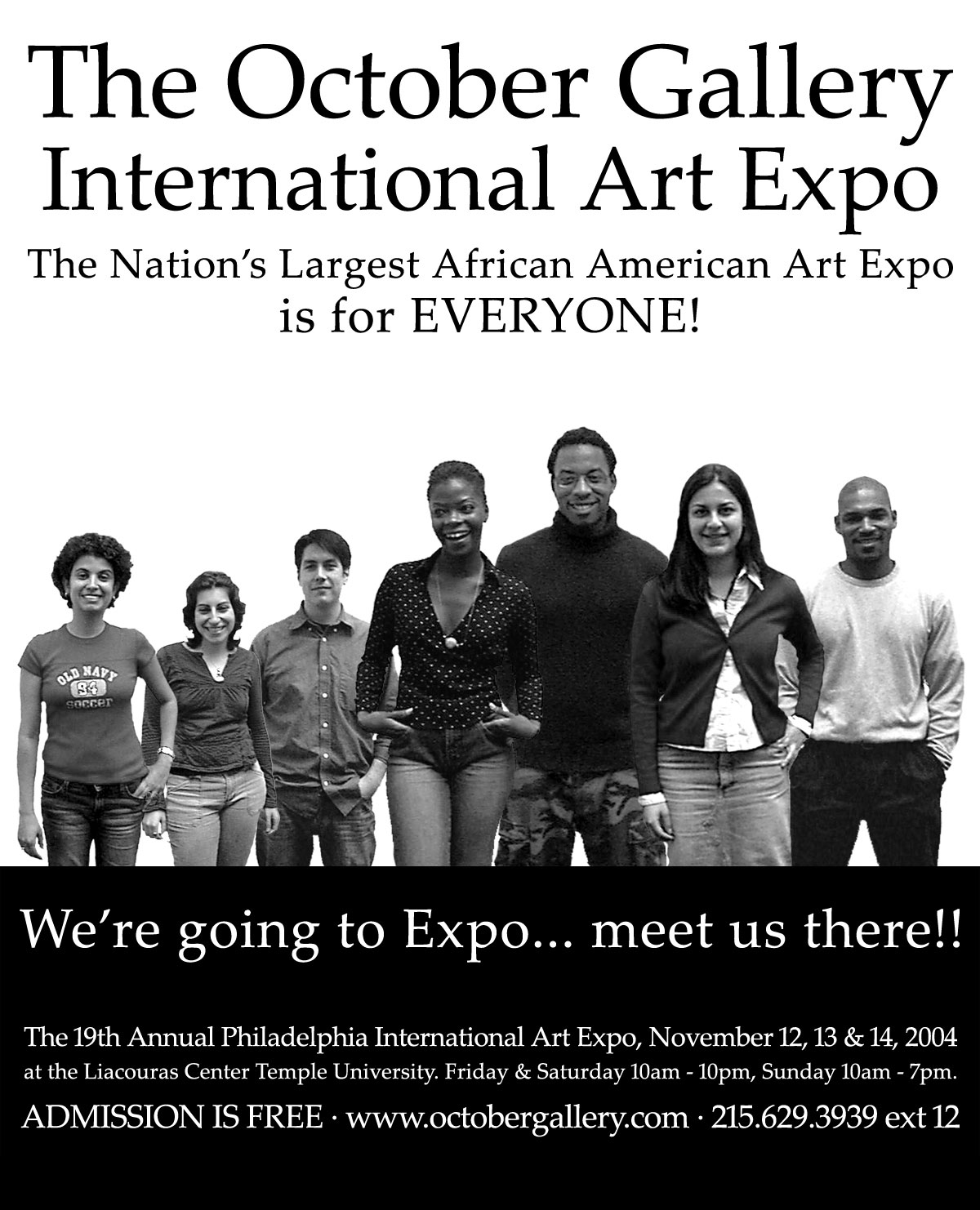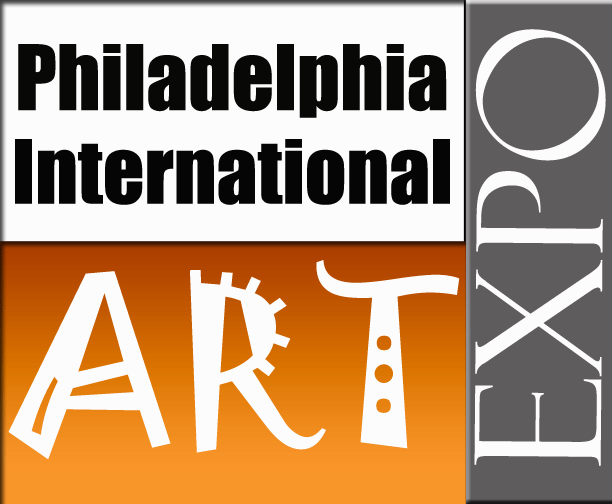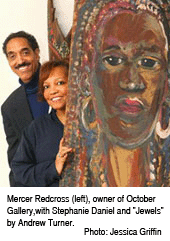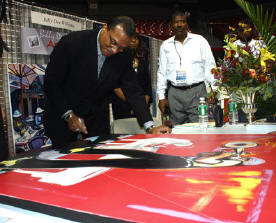Mercer A. Redcross III outside and Evelyn Redcross inside
the first location for the gallery.
October Gallery 3805 Lancaster Ave. Philadelphia, PA 19104.
Year 1986.
October Gallery Donates 170 Pieces of Art to Cheyney University 2008
African American art in all its variety – Little Rock Nine
Nine African American students stand against a brilliantly colored backdrop. Courage is emblazoned at their feet. Clutching their books, they appear determined and ready to learn in an integrated environment.
The scene, a serigraph by artist Charly Palmer, is titled Little Rock Nine – 50 Years, a piece commissioned to commemorate the enrollment of nine African American students at an Arkansas high school after the Supreme Court ruled that segregated schools offered inherently unequal education.
The piece will be unveiled at 6:30 tonight during October Gallery’s 22d annual Philadelphia International Art Expo, held this weekend at Temple University’s Liacouras Center. Ernest Green, one of the nine Little Rock students, is scheduled to attend the unveiling ceremony.
Described as the nation’s largest African American Art Expo, the show is projected to draw more than 50,000 people, organizers said. About 150 artists from 45 states and eight countries will exhibit paintings, sculptures, jewelry and crafts.
“Connecting People With Art,” this year’s theme, will resonate during the three-day expo with art auctions, seminars, poetry and other art demonstrations.
Chess tournaments will be offered from 1 to 5:30 p.m. all three days. An art contest, with youth and adult divisions, will be open to entries from the public. A Latin American/Caribbean Art Pavilion and a Health Pavilion with health screenings are planned.
Expo organizers encourage all art lovers to attend. Stephanie Daniel, October Gallery’s spokeswoman, said that 40 percent of this year’s artists are newcomers, many hailing from Canada, the Caribbean, Brazil, Africa and Europe.
David Lawrence, executive associate for October Gallery, said the expo also is an effort to help support artists financially.
“It’s one thing to be admired for your work, but that doesn’t help pay the bills,” said Lawrence, a mixed-media artist. By attending the expo and buying artwork, he said, patrons can “help the survival of the artist and their commitment to bringing the greatest art that they can to the community.”
Daniel echoed his sentiments. “This is the only way you’re going to see what all the popular African American artists are doing. Take a few hours and go down there,” she said, “even if you don’t purchase a thing.”
The Philadelphia International Art Expo 2007, “Connecting People With Art,” is open 10 a.m.-10 p.m. today and Saturday and 10 a.m.-7 p.m. Sunday at the Liacouras Center, 1776 N. Broad St. Admission is free. Information: 215-629-3939 or www.octobergallery.com.
Contact Venuri Siriwardane at 215-854-4193 or vsiriwardane@phillynews.com.
October Gallery’s Paint Magzine
African American art in all its variety
Nine African American students stand against a brilliantly colored backdrop. Courage is emblazoned at their feet. Clutching their books, they appear determined and ready to learn in an integrated environment.
The scene, a serigraph by artist Charly Palmer, is titled Little Rock Nine – 50 Years, a piece commissioned to commemorate the enrollment of nine African American students at an Arkansas high school after the Supreme Court ruled that segregated schools offered inherently unequal education.
The piece will be unveiled at 6:30 tonight during October Gallery’s 22d annual Philadelphia International Art Expo, held this weekend at Temple University’s Liacouras Center. Ernest Green, one of the nine Little Rock students, is scheduled to attend the unveiling ceremony.
Described as the nation’s largest African American Art Expo, the show is projected to draw more than 50,000 people, organizers said. About 150 artists from 45 states and eight countries will exhibit paintings, sculptures, jewelry and crafts.
“Connecting People With Art,” this year’s theme, will resonate during the three-day expo with art auctions, seminars, poetry and other art demonstrations.
Chess tournaments will be offered from 1 to 5:30 p.m. all three days. An art contest, with youth and adult divisions, will be open to entries from the public. A Latin American/Caribbean Art Pavilion and a Health Pavilion with health screenings are planned.
Expo organizers encourage all art lovers to attend. Stephanie Daniel, October Gallery’s spokeswoman, said that 40 percent of this year’s artists are newcomers, many hailing from Canada, the Caribbean, Brazil, Africa and Europe.
David Lawrence, executive associate for October Gallery, said the expo also is an effort to help support artists financially.
“It’s one thing to be admired for your work, but that doesn’t help pay the bills,” said Lawrence, a mixed-media artist. By attending the expo and buying artwork, he said, patrons can “help the survival of the artist and their commitment to bringing the greatest art that they can to the community.”
Daniel echoed his sentiments. “This is the only way you’re going to see what all the popular African American artists are doing. Take a few hours and go down there,” she said, “even if you don’t purchase a thing.”
The Philadelphia International Art Expo 2007, “Connecting People With Art,” is open 10 a.m.-10 p.m. today and Saturday and 10 a.m.-7 p.m. Sunday at the Liacouras Center, 1776 N. Broad St. Admission is free. Information: 215-629-3939 or www.octobergallery.com.
Chess Meet at October Gallery Art Expo 2007.
![]()
![]()

With artists from over 40 states and 6 countries, this year’s 22nd Annual Philadelphia Art Expoheld at Temple University’s Liacouras Center, proved to be a treat. This event did not disappoint. Such artists as Jacob Lawrence, Romare Bearden, Cal Massey, and William Tolliver made the trek to Philly to show their works to over 40,000 enthusiastic attendees.
To keep you occupied , this Expo had everything from body painting, a fashion show, art auction, live music and poetry, as well as a holistic center for the healthy. With an event such as this , it’s no wonder such luminaries like Isaac Hayes and Billy Dee Williams have demonstrated their works here in the past.
What makes this exciting for chessplayers, is for the first time a chess tournament was included with $6000 in prizes guaranteed. This was enough to attract strong players likeIM Alex Lenderman from New York, IM Bryan Smith, FM William Morrison from Maryland and NM Elvin Wilson.
This tournament was unique in the fact that, it was actually three separate unrated events. Each day consisted of four G/30 games with separate prizes for high scoring unrated players. IM Bryan Smith seemed to have his game face on all weekend, sharing 1st place each day he played.
First place was shared on Friday by IM Bryan Smith, NM Elvin Wilson and David Apelo from New York. Saturday’s 1st place prize was split by IM Bryan Smith and FM William Morrison. Sunday’s prize was split between Bryan Smith and David Apelo.
Philly locals like Larry Pugh and Jeffrey Johnson also played but found out that everyone came to play and there would be no cakewalks.
Overall, the event was a nice addition to an already creative environment. This being the first year, low attendance was somewhat understandable. I anticipate this event will grow is size over the years.
“Pete” Honored!
On Saturday evening, Norman “Pete” Rogers was presented with an award from the city as well as a painting donated by October Gallery. This was a lifetime achievement award for over 30 years of dedication to this city and our game.

Michael Williams (at podium) helps in awarding Norman “Pete” Rogers with a Lifetime Achievement Award. Also presenting were Glenn Bady and Elvin Wilson. Photo courtesy of Michael Williams
I would personally like to thank Mercer Redcross and his family for sponsoring this event. I would also like to thank those who came out and supported. Next year’s event promises to be just as exciting and entertaining. Hope to see everyone there!
Some of these pictures were allowed to be taken due the courtesy of jtrollinschesstables.com and Amaze Art Gallery.
~ Michael L Williams
Panoramic Poetry – Taalam – at Cheyney University
COLLECTING CONNECTIONS Younger African Americans are finding value in acquiring “legacy pieces” by black artists.
Saniah Johnson hopped from booth to booth at the 21st annual Philadelphia International Art Expo last month, taking in the plethora of paintings, sketches, serigraphs, sculptures and dolls created by African American artists.
While Johnson, 32, appreciates the works of the Eakinses and Wyeths, she feels drawn to the richness of art from her culture. She already owns two pieces by Andrew Turner, the prolific Philadelphia artist who died in 2001, and is eager to expand her collection.
“It was one thing to own a poster in college,” said Johnson, an assistant vice president for financial planning and reporting at Delaware Investments. “Now I’m finding myself wanting to own originals. I’m looking for legacy pieces.”
Johnson is one of a growing number of young African American professionals who have been drawn to collecting black art, making moot the generalization that serious collecting starts at about age 40 or older.
With good jobs, more disposable income, and more places to experience art, they are realizing that art fits nicely in their upwardly mobile lives and homes, and often turns out to be a good investment.
“After some people buy the first piece, they are scared to death. They can’t drive it and they can’t live in it,” said Lamar Redcross, 34, director of the October Gallery, which produces the Philadelphia International expo.
But, Redcross said, the new buyers “get over it” and come looking for more.
“Some of them grew up in families that didn’t have a lot of money but they knew there was this one piece in the house they weren’t allowed to touch,” he said. “Now these young people have careers and are educating themselves about art.”
Celebrities have brought cachet to the practice as well. Basketball star Grant Hill’s collection of African American art, including works by Romare Bearden, John Biggers and Elizabeth Catlett, appeared in museums across the country on a three-year tour that ended in July.
A few weeks back, hip-hop honcho Jay-Z reportedly dropped $2 million on a Jean-Michel Basquiat painting, a gift for girlfriend Beyonc.
And some artists, such as Kehinde Wiley, whose Old World-meets-hip-hop-styled paintings of young African American men have been snapped up by the likes of Denzel Washington, have themselves become celebrities. Wiley, 29, is featured this month in the art issue of Vanity Fair.
Some collectors say the increased exposure to the wide array of work by black artists shows there are often affordable “true” art options to the inexpensive prints and velvet posters that some grew up with. And others recall seeing their parents host or attend “art parties,” events held in homes that brought together small groups to view and buy black art.
For some new collectors, such as Racquel Bruton, 34, a clinical trials manager from Lansdowne, collecting began out of the notion that art “brings an identity to one’s home.”
When she was growing up, one side of her family displayed family portraits. The other side, she said, “would have the white Jesus on their wall.”
“Going to art galleries and expos showed me there’s art that truly expresses my interest,” said Bruton, whose collection includes a work by Ernie Barnes. “The art I have on my walls is a reflection of who I am. When people come to your home they see your art and they can tell.”
It is clear from the walls at Sterling Johnson’s South Philadelphia home that he has an affinity for African American art.
At 47, he has amassed more than 200 pieces; the first was a Sylvia Walker watercolor purchased in 1991. Other artists include Bearden, Allan Edmunds, Charles Smith and Joe Barker.
Johnson goes beyond mere collecting, as he has developed relationships with artists so he can find out “what goes into” the works. He also educates his friends about art, and organizes visits to galleries along the East Coast throughout the year.
“As soon as I graduated from college and realized I could purchase art, I was hooked,” said Johnson, a civil engineer. “Before that, it just felt like something you’d look at in a museum.”
Gallery owners have taken notice. At Collectible Art & Frame, owner May Allan said that customers have upgraded from unsigned prints to more original or limited edition works from artists such as Charles Bibbs, Annie Lee, Alonzo Adams from New Jersey, and Philadelphian Laurie Cooper.
At Allan’s well-stocked Chestnut Street gallery, about 95 percent of the works are by African American artists, including several from the Philadelphia area. Originals sell for as much as $15,000, but buyers spend an average of about $4,000 for an original and about $1,500 for a limited-edition print.
“They’re not just looking for decorative pieces,” said Allan, who has seen an uptick in younger clients. “People used to come in and ask for the painting with the woman sitting in church or the man on the park bench. Now they know the names, they are looking at value, and they want to know more about the artists.”
The galleries have also become popular social outlets, serving as meeting places for young professional groups, fraternities and sororities, and alumni outings. Museums, too, such as the African American Museum in Philadelphia, have formed groups for young professionals.
Shawn Benjamin, 38, got bitten by the art bug while attending a Cornell University black alumni fund-raiser at October Gallery. There, gallery founder Mercer Redcross (Lamar’s father) gave one of his famous art-appreciation lectures, explaining the difference between various forms and teaching attendees how to recognize pieces that would appreciate in value.
“At that time, my apartment was decorated with posters from Ikea,” said Benjamin, a Realtor from Wynnefield Heights. “After hearing him, I said, ‘Not only can I beautify my home with art from people who are showing our culture in a beautiful way, but there could be an added bonus.’ . . . I bought a piece that day.”
Benjamin now owns “well over 20 pieces” by black artists, including five original Turners and a $3,500 limited-edition Bearden from the “Prevalence of Ritual” series. Four years ago, he had the Bearden appraised – for $10,000.
“But the real value is not in the dollar amount,” Benjamin said. “This is art you’re connected to.”
Contact staff writer Dwayne Campbell at 215-854-5315 or dcampbell@phillynews.com.
Finding African American Art
Art Around Gallery
2011 Chestnut St. 215-972-1644
Art on the Avenue
3808 Lancaster Ave. 215-387-0401
Brandywine Workshop
730 S. Broad St. 215-546-3675. www.brandywineworkshop.com
ArtJaz Gallery
53 N. Second St. 215-922-4800. www.artjaz.com
Collectible Art & Frames
2044 Chestnut St. 215-629-8654. www.collectibleart.com
Dupree Studios Inc. Gallery
703 S. Sixth St. 215-413-3884. www.dupreestudiosinc.com
October Gallery
7175A Ogontz Ave. 215-629-3939. www.octobergallery.com
Perfect Touch Gallery
50th Street and City Avenue. 215-879-1879.
Sande Webster Gallery
2006 Walnut St. 215-636-9003. www.sandewebstergallery.com
The Young Friends Society of the African American Museum in Philadelphia can be reached at 215-574-0380, Ext. 222.
Behind the Glass: The People Who Place African American Art On Philadelphia’s Pedestals
The Greater Philadelphia Tourism Marketing Corporation (GPTMC)
Nov 10 2006
Name: Sande Webster
Affiliation: Sande Webster Gallery
Her Story: Sande Webster’s track record for shattering stereotypes has made her one of the most revered individuals in Philadelphia’s art scene. Armed with a master’s degree in physics, she worked at the Berg Art Gallery in nearby Jenkintown prior to collaborating with fellow entrepreneurs to open the Wallnuts of Locust Street Gallery in Center City in 1969. Webster and her partners took many artistic risks, regularly featuring African American painters, sculptors and printmakers; organizing exhibitions with social and political implications; and displaying glass, clay and textiles in a different way than what many were used to in the craft world. Though local industry peers predicted the Wallnuts’ early demise, Webster’s gallery has thrived for nearly 40 years. More than 25 years ago, it became the Sande Webster Gallery. Cementing her rightful place at the forefront of the African American arts movement, researchers interviewed her in 1990 for the Smithsonian’s Oral History Program. Recordings from those interviews are now a permanent part of the Archives of American Art.
Name: Cheryl McClenney-Brooker
Affiliation: Philadelphia Museum of Art
Her Story: In addition to her role as director of external affairs for one of the largest art museums in the nation, Cheryl McClenney-Brooker advocates for Philadelphia’s up-and-coming artists and promotes the arts as a conduit for strengthening communities. She is a member of the Pennsylvania Historical and Museum Commission, serves on the Pennsylvania Humanities Council and the Philadelphia Cultural Fund and sits on the board of the African American Museum in Philadelphia and the Multicultural Affairs Congress of the Philadelphia Convention and Visitors Bureau. Once the director of humanities projects at the National Endowment for the Humanities in Washington, D.C., Brooker now helps give thousands of dollars in grants earmarked for non-profit arts and cultural programming within the city, exposing Philadelphians to a broader range of artistic experiences.
Name: Moe Brooker
Affiliation: Moore College of Art and Design
His Story: Few artists can boast a commission from Absolut Vodka. But somewhere within Moe Brooker’s portfolio is an “Absolut Brooker” ad, which would probably be a shock to his students at Philadelphia’s Moore College of Art and Design—the nation’s first and only women’s college devoted to the visual arts. In addition to serving as chair of the basics department, Brooker teaches two-dimensional design and painting, but his impact is felt far beyond the classroom walls. His works are scattered throughout the city and the country and can be found among collections as the Federal Reserve Bank in Philadelphia, The Kimmel Center for the Performing Arts, the Woodmere Art Museum and the Pennsylvania Academy of the Fine Arts. Both the Cleveland Museum and its public library feature his paintings, as do The Studio Museum in Harlem and the Montgomery Museum of Fine Arts in Montgomery, Alabama.
Name: Pamela Brown and Beverly Dawson
Affiliation: ArtJaz Gallery
Their Story: Pamela Brown and Beverly Dawson first opened the doors of ArtJaz Gallery in 1999. Their goal was to garner awareness of and provide exposure for emerging and established artists of color. Works displayed in the Old City gallery stretch across a number of mediums, including acrylic, oil, mixed media, ceramic and sculpture. Recognizing art and music as truly free forms of expression, ArtJaz fulfilled its mission with a recent exhibition featuring the photography of noted R&B and jazz singer Will Downing. His images, along with the works of seven other artists represented by ArtJaz, have been compiled and published in Unveiled. Constantly developing innovative shows, Brown and Dawson will host a group exhibition from mid-November through December 2006, featuring the work of Charly Palmer, Sonia Sadler, Deborah Shedrick and Jackson-Collins.
Name: Richard Watson
Affiliation: African American Museum in Philadelphia
His Story: By the time Richard Watson enrolled at the Pennsylvania Academy of the Fine Arts, he had already found solace in splashing watercolors on the canvas. While a student, he honed his sketching and painting techniques, observing the social changes produced during the antiwar and Civil Rights movements of the ‘60s. Soon he began working on community art projects, collaborating withFreedom Theater and the Church of the Advocate. He also accepted invitations to join Philadelphia’s famous mural legacy. Today, Watson’s body of work can be identified by one of three themes—all of which infuse some element of the African American experience: landscapes, usually including a sharecropper; contemporary women placed in a charming and romantic scenario; and works which allow Watson to form a dialogue with his ancestors. Courtesy of the collage movement, he has shifted from student to mentor, as newer artists explore his concept of introducing three-dimensional objects in their paintings. As curator for the African American Museum in Philadelphia’s art collection, Watson is now responsible for preserving the works of those he studied for future generations to appreciate.
Name: Kimberly Camp
Affiliation: Painter, Doll maker
Her Story: Kimberly Camp’s numerous magazine interviews reveal a fascinating cross section of admirers: Essence, The New York Times, National Geographic World and the Village Voice, to name a few. Besides hosting doll-making workshops at the Smithsonian and along the East Coast, her handcrafted dolls and paintings can be found among the private collections of such notable individuals as Judith Jamison, Faith Ringgold and Delroy and Nashormeh Lindo. A two-time recipient of National Endowment for the Arts Fellowships, Camp spent seven years as president and CEO of The Barnes Foundation in Merion, orchestrating the first catalogue project of the institution’s entire collection—totaling nearly 9,000 works of art.
Name: Allan Edmunds
Affiliation: Brandywine Workshop
His Story: Known as one of Philadelphia’s little-known treasures, the Brandywine Workshop is located on the Avenue of the Arts in Center City. Master printmaker Allan Edmunds founded the Workshop in 1972 to impart his knowledge with area artists and students, instructing them in the craft of printmaking. Throughout the years, Edmunds’ wide-reaching influence crossed state and national borders—the Workshop has sponsored more than 280 artists’ residencies from 35 states and 15 countries to share bindery, screen-printing and lithographical techniques with their peers and the public. As an artist, Edmunds’ work has been featured in such exhibitions as Successions: Prints by African American Artists from the Jean and Robert Steele Collection at the University of Maryland, and the University of Delaware has showcased the prints of Edmunds’ protégés. Edmunds also edited what is thought to be the first inclusive book to research the contributions of artists of color on American printmaking, offering a distinctive reference for art collectors.
Name: Pauline Houston-McCall
Affiliation: Women Holler! Art Collective
Her Story: A self-described “soul artist and renegade,” Houston-McCall’s spirituality and sense of conviction are the inspiration for her drawings, sculptures and paintings, many of which are sizable works. Once a student at Moore College of Art and Design, she uses charcoal, paper, glass, burlap and wood to relay her African and Native American ancestors’ stories of injustice. A social activist, Houston-McCall founded Women Holler!, a nationally acclaimed group of women artists and educators who encourage each other through the creative process. The network includes women of African American, Colombian, Vietnamese and European American heritage. Assertive and candid, the collective offers universal insight into the woman’s mind via its Womanifesto: “Women Holler! Because we need a cigarette/drink/nap/orgasm/chocolate.”
Name: Lamar Redcross
Affiliation: October Gallery
His Story: October Gallery has established its identity as a conduit for art education. For years, Lamar Redcross has been forming a convincing argument that art can be more than an object that collects dust on the bookshelf—that art can be considered a quality investment. But Redcross understands his job doesn’t end once a first-time buyer enters the gallery. It’s crucial to then offer trustworthy, qualified advice about potential purchases, recommending an artist whose style matches a customer’s taste. Having updated the gallery’s use of technology to assist clients, the growth of Redcross’ art education movement is best reflected in the widespread popularity of the annual International Art Expo, which celebrates its 21st year in 2006. Over three days, approximately 40,000 visitors are expected to canvass Temple University’s Liacouras Center to see the works of more than 100 emerging and established contemporary African American artists.
The Greater Philadelphia Tourism Marketing Corporation (GPTMC) makes Philadelphia and The Countryside™ a premier destination through marketing and image building that increases business and promotes the region’s vitality. For more information about travel to Philadelphia, visitwww.gophila.com or call the Independence Visitor Center, located in Independence National Historical Park, at (800) 537-7676.
Acquiring African American Art Made Easy in Philly
Nov 10 2006
Local Gallery Owners Put Art Buyers At Ease
- Part of Philadelphia’s next generation of galleries, Art Around Gallery has popped up not too far from the Rittenhouse Square neighborhood, taking advantage of its proximity to the Marketplace Design Center. Welcoming a different artist each month, the gallery offers enough space to display 30 works. Within three years of its opening, Art Around has found success featuring primarily African American fine art from collages and cartoon art to paintings and sculptures. 2011 Chestnut Street, (215) 972-1644
- Old City’s First Fridays offer a prime opportunity to discover ArtJaz Gallery and embrace the differing perspectives and changing imagery across the African Diaspora. Established in 1999, the gallery cultivates the works of emerging and career artists of color. Through exhibitions and community collaboration, owners Pamela Brown and Beverly Dawson create a forum in which regional, national and international artists can be heard. 53 N. 2nd Street, (215) 922-4800, www.artjaz.com
- Housed in a certified historic landmark, the Brandywine Workshop has led the development of printmaking as a fine art form. Since its inception, the Workshop has sponsored more than 280 artists’ residencies from 35 states and 15 countries. The space includes two galleries for displaying works: the Henry O. Tanner Gallery features traveling exhibitions, prints from the collection and the work of young artists, while the Printed Image Gallery presents culturally and aesthetically diverse contemporary exhibitions from around the world. 730 S. Broad Street, (215) 546-3675,www.brandywineworkshop.com
- For decades, the Sande Webster Gallery has been exhibiting provocative prints, paintings, drawings, photographs, sculptures and glassworks by emerging and established artists of color. The gallery hosts the occasional panel discussion where visitors can express their reactions, but the staff is receptive to good conversation anytime. 2006 Walnut Street, (215) 636-9003, www.sandewebstergallery.com
- October Gallery is best recognized for organizing the annual Philadelphia International Art Expo, one of the most recognized public shows in the country. The three-day event features the works of 100-plus visual artists. Throughout the year, October Gallery, which recently relocated to West Oak Lane after nearly 20 years in Old City, exhibits primarily paintings and prints by local, national and international contemporary artists. 7175A Ogontz Avenue, (215) 629-3939, www.octobergallery.com
The Greater Philadelphia Tourism Marketing Corporation (GPTMC) makes Philadelphia and The Countryside™ a premier destination through marketing and image building that increases business and promotes the region’s vitality. For more information about travel to Philadelphia, visitwww.gophila.com or call the Independence Visitor Center, located in Independence National Historical Park, at (800) 537-7676.
Arts and Aesthetics Collective Expo 21 – 2006
Excerpt from Philadelphia Daily News
Nov. 6, 2006
By Robert Strauss
Black (art) is Beautiful
African-American works highlighted at Liacouras Center this weekend
Stephanie Daniel is helping promote the 21st Annual October Gallery Philadelphia International Art Expo, Friday through Sunday at the Liacouras Center at Temple University, an event expected to attract more than 40,000 current and potential collectors of art of all kinds made by African-Americans.
To accompany the expo, Redcross and the October Gallery have produced “Connecting People with Contemporary African American Art,” a 500-page, full-color coffee-table book chronicling the rise of art and art collecting by African-Americans.
Daniel, for her part, thinks that rise came not from a push in formal art appreciation but from a less highfalutin form – the TV shows “Good Times” and “The Cosby Show.”
‘Image of sophistication’
The main character on “Good Times,” which ran from 1974-79, J.J. Evans, played by Jimmy Walker, was an artist, but the art displayed on the show was mainly done by a seasoned painter, Ernie Barnes.
Then, from 1984-92, sets for “The Cosby Show” often had art of all types hanging on the walls in the family house.
“It became mainstream in African-American homes after that to have something on the wall, even if it was just a $15 poster,” said Daniel. “It was an image of sophistication we suddenly wanted to have.”
Still, people who wanted to buy original African-American art, particularly in Philadelphia, would have had a little trouble back in those days.
“Three months after going into business nearly 40 years ago, a gallery owner called to welcome me to the community,” said Sande Webster, whose eponymous gallery is at 20th and Walnut streets. “She said she had heard I was going to display black artists, and she warned me that if I did and black people would come to the gallery, then white people wouldn’t and I would go out of business.”
Webster said she ignored the advice and that when she has shown black artists – her gallery now is featuring Moe Brooker, an impressionist – she has had no problem attracting buyers.
“I would defy anyone coming in, year after year, to tell me what works were done by white artists and which ones were done by black artists,” said Webster. “I’m of the opinion that while art is surely the sum of the artist’s experience, it isn’t ‘black’ or ‘white,’ per se.
A brush with a star at art expo in Phila. Billy Dee Williams was the featured guest at a show that allows visitors to rub elbows with black artists.
With all the camera phones, video recorders, and people lining up for autographs, it was easy to tell there was a celebrity in the room.
Yesterday, Billy Dee Williams, known for roles in Lady Sings the Blues and Brian’s Song, was busy signing autographs and posing for photos.
But the man known to many as Lando Calrissian in The Empire Strikes Back and Return of the Jedi wasn’t promoting a new television series or out on the road filming a movie.
Williams was in town as the featured artist for the 21st Annual October Gallery Philadelphia International Art Expo, held at the Liacouras Center at Temple University. This year’s theme is “Connecting People With Art.”
By the time the show ends today, 40,000 people will have visited the Liacouras Center to see about 140 artists from the United States, Africa, Canada and the Caribbean. About 50 percent of the artists this year exhibited for the first time.
Williams, who has donated his artwork to the National Portrait Gallery in Washington and the Schomburg Center in New York, said he had been painting and drawing all his life.
“My whole life has revolved around creativity,” said Williams, who considers himself a “lucky person” to be able to do what he loves. “It is a wonderful, satisfying way to live one’s life.”
The event is the largest African American art expo in the country, according to Stephanie Daniel, spokeswoman for October Gallery.
“This is one of the few places where you can see so many black artists and their work,” said James Stewart, who, along with his wife, Caryl Sheffield, came from Pittsburgh for the exhibit. The two liked to interact with the artists and get to know them.
“We just bought three Frank Fraziers,” Sheffield said.
Frazier, 63, of Dallas, grew up in New York but ran away to Philadelphia as a teenager.
“They found me lying in the gutter in front of The Inquirer, hustling and trying to survive,” Frazier said, recalling how his family came and got him.
Later, Frazier, who started painting at age 15, joined the Army and sent sketches on the back of matchbooks and C ration wrapping back from Vietnam to his family.
Now a noted artist who is working on a series of paintings on the civil rights movement, Frazier sees the art expo as a place for new and established artists to meet.
“We get a chance to socialize together and pass the torch on,” he said. Frazier has been coming to the exhibit for 18 years and noted that some of the artists exhibiting this weekend, such as Robert Carter and Paul Goodnight, are “living legends” in their field.
Carter, an artist and professor at Nassau Community College on Long Island, said the exposure to African American artists and the practical aspect of selling art are a “pragmatic” part of the art expo.
“If no one is in the audience, you can’t produce a play,” said Carter, who was wrapping up two prints of some of his work for a buyer.
Contact staff writer Mari A. Schaefer at 610-892-9149 or mschaefer@phillynews.com.
Art Expo Information
The 21st Annual October Gallery Philadelphia International Art Expo continues today, from 10 a.m. to 7 p.m. at the Liacouras Center at Temple University, 1776 N. Broad St. Admission is free.
About 140 artists will be exhibiting fine arts, crafts, books and jewelry.
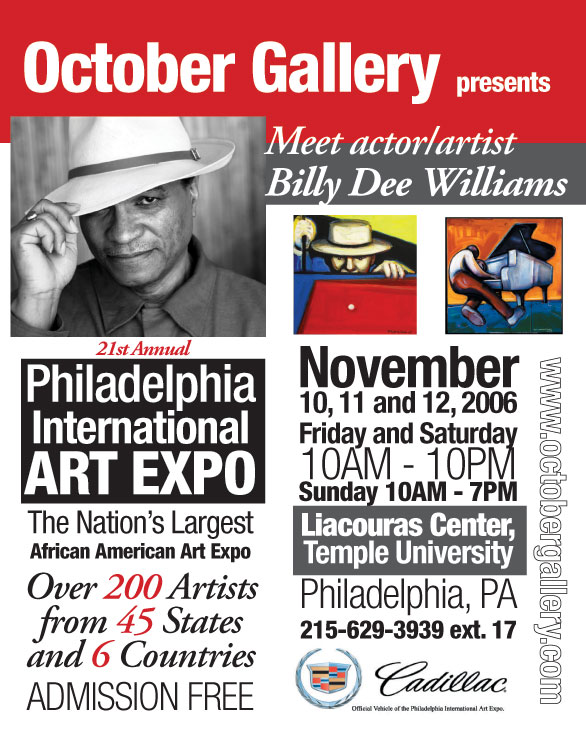
Black (art) is beautiful African-American works highlighted at Liacouras Center this weekend
WHEN STEPHANIE Daniel was growing up in Boston, going to visit relatives on Martha’s Vineyard in Massachusetts every summer, the idea that there was an African-American art community was not really a part of her consciousness.
“Sometimes people just want art that, when they come home, they get to see someone who looks like them, but sometimes, they just want something hanging up there that they like,” said Daniel.
So a few years ago, when she saw a painting of Gay Head, a section of Martha’s Vineyard, that her friend Mercer Redcross had at his October Gallery in Old City, she knew she just had to have it. That it was painted by Chester-based African-American artist Sam Benson was just a plus.
“It’s just a beautiful landscape,” said Daniel. “It doesn’t say, ‘African-American.’ I just think African-Americans have now matured and become more confident as art collectors.”
Daniel is helping promote the 21st Annual October Gallery Philadelphia International Art Expo, Friday through Sunday at the Liacouras Center at Temple University, an event expected to attract more than 40,000 current and potential collectors of art of all kinds made by African-Americans.
To accompany the expo, Redcross and the October Gallery have produced “Connecting People with Contemporary African American Art,” a 500-page, full-color coffee-table book chronicling the rise of art and art collecting by African-Americans.
Daniel, for her part, thinks that rise came not from a push in formal art appreciation but from a less highfalutin form – the TV shows “Good Times” and “The Cosby Show.”
‘Image of sophistication’
The main character on “Good Times,” which ran from 1974-79, J.J. Evans, played by Jimmy Walker, was an artist, but the art displayed on the show was mainly done by a seasoned painter, Ernie Barnes.
Then, from 1984-92, sets for “The Cosby Show” often had art of all types hanging on the walls in the family house.
“It became mainstream in African-American homes after that to have something on the wall, even if it was just a $15 poster,” said Daniel. “It was an image of sophistication we suddenly wanted to have.”
Still, people who wanted to buy original African-American art, particularly in Philadelphia, would have had a little trouble back in those days.
“Three months after going into business nearly 40 years ago, a gallery owner called to welcome me to the community,” said Sande Webster, whose eponymous gallery is at 20th and Walnut streets. “She said she had heard I was going to display black artists, and she warned me that if I did and black people would come to the gallery, then white people wouldn’t and I would go out of business.”
Webster said she ignored the advice and that when she has shown black artists – her gallery now is featuring Moe Brooker, an impressionist – she has had no problem attracting buyers.
“I would defy anyone coming in, year after year, to tell me what works were done by white artists and which ones were done by black artists,” said Webster. “I’m of the opinion that while art is surely the sum of the artist’s experience, it isn’t ‘black’ or ‘white,’ per se.”
Supporting the community
There are those who disagree with Webster, though, and prefer to spend their collecting money that way.
Cheryl Oliver-Knight, a Philadelphia School District administrator, went to an exhibit of African-American art with a friend nearly 20 years ago and decided that she, as an African-American, should support that community.
“I had moved into a house instead of an apartment, so I needed to put things up on the bare walls,” said Oliver-Knight. She liked several small paintings of black angels, which went up around the house. Then, little by little, she started buying more colorful and larger works.
She has prints by national figures such as Californian Charles Bibbs and locals like Sam Byrd.
An executive’s decision
It was that sentiment that got Hal Sorgenti to start collecting African-American art.
When he and his wife, Lyn, were married, his father-in-law gave them two paintings by an unknown black artist titled “Wooing of the Twins in Blackville” and “Coaching Season in Blackville.” As much as he loved the paintings, Sorgenti, at the insistence of his wife, taped over “Blackville” on the paintings’ labels because she thought the term offensive.
“It was the times, so we wanted to be sensitive,” said Sorgenti, but as the 1970s and 1980s progressed, the Sorgentis sought out more African-American art. When he was CEO of ARCO Chemical Co. in the 1980s, and it moved to a new campus in Newtown Square, he insisted on putting art by African-Americans throughout.Because the art was not in demand, the company paid about $250,000 for 100 pieces.
When ARCO was sold to Lyondell Petrochemical in 1998, the new company didn’t want the art, so Sorgenti bought it himself for the original price and donated it to the Pennsylvania Academy of Fine Arts. It has recently been appraised at more than $3 million.
“Clearly, people appreciate African-American art more these days,” he said. Though he is white, Sorgenti said, the main buying public is black.
“Especially for the pieces dealing with the African-American experience, the crowd at the gallery will be black, and that is a good thing. Eventually, it won’t matter, but I am happy I invested in it long ago.”
IF YOU GO
Philadelphia International Art Expo, 10 a.m.-10 p.m. Friday-Saturday, 10 a.m.-6 p.m. Sunday.
Liacouras Center, 1776 N. Broad St. Admission is free. For more information, call October Gallery at 215-629-3939, Ext. 17, or go to www.octobergallery.com.
Tom Joyner and Andrew Turner Artwork
October Gallery Celebrates 20 Years
